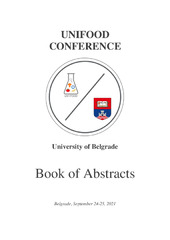Приказ основних података о документу
From raw starch degrading α-amylase to transglycosylase by single point mutation
| dc.creator | Božić, Nataša | |
| dc.date.accessioned | 2023-03-01T23:15:00Z | |
| dc.date.available | 2023-03-01T23:15:00Z | |
| dc.date.issued | 2021 | |
| dc.identifier.isbn | 978-86-7522-066-4 | |
| dc.identifier.uri | https://cer.ihtm.bg.ac.rs/handle/123456789/5860 | |
| dc.description.abstract | Understanding the structural peculiarities and properties of both, raw starch as a substrate and raw starch digesting amylases (RSDA) as an enzymes is needed for efficient application in food and other industries. Although knowledge of these structures and properties has increased significantly in recent years, the main requirement defining whether RSDA will be efficient in raw starch hydrolysis is still a riddle. We have recently identified the surface binding site (SBS) of a potent RSDA from Bacillus paralicheniformis ATCC 9945a (BliAmy), by crystallographic study of its native form and in complexes with maltose, acarbose, maltohexaose and β-cyclodextrin. To understand role of this SBS, the two key residues identified, Phe257 and Tyr358, were mutated. Kinetic studies show that starch binding through the SBS is disrupted in the mutants and that both mutants contributed cumulatively to binding and degradation. Mutation of both sites resulted in at least 5.5 fold weaker binding and 5 fold lower efficacy with raw starch as substrate compared to the wild type BliAmy suggesting that the ability of BliAmy to hydrolyze raw starch with high efficiency is related to the level of its adsorption onto starch granule. RSDA was further exploited for its robustness by changing its activity and converting this hydrolase into transglycosylase. The use of transglycosylases for synthetic purposes is limited since, unlike hydrolases, these enzymes are relatively rare in nature, and act on a limited substrate repertoire. To alter the activity of BliAmy, His235 was replaced with Glu. The mode of action of the mutant enzyme was tested using substrates such as starch, amylopectin, maltooligosaccharides etc. Mutant exhibited transglycosylation activity, while wild type BliAmy exhibited hydrolysis activity exclusively. Converting hyperthermostable BliAmy into transglycosylase provides potent tool in the synthesis of starch derivatives. The production of starchy foods with slow digestion properties, and thus a low glycemic index, is therefore an important goal of the modern food industry. | sr |
| dc.language.iso | en | sr |
| dc.publisher | University of Belgrade | sr |
| dc.relation | info:eu-repo/grantAgreement/MESTD/inst-2020/200026/RS// | sr |
| dc.relation | info:eu-repo/grantAgreement/MESTD/inst-2020/200168/RS// | sr |
| dc.rights | openAccess | sr |
| dc.rights.uri | https://creativecommons.org/licenses/by/4.0/ | |
| dc.source | Book of Abstracts - 2nd UNIFood International Conference - UNIFood2021, September 24-25, 2021, Belgrade | sr |
| dc.subject | transglycosylase | sr |
| dc.subject | raw starch | sr |
| dc.subject | mutation | sr |
| dc.subject | α-amylase | sr |
| dc.title | From raw starch degrading α-amylase to transglycosylase by single point mutation | sr |
| dc.type | conferenceObject | sr |
| dc.rights.license | BY | sr |
| dc.citation.spage | 13 | |
| dc.citation.epage | 13 | |
| dc.identifier.rcub | https://hdl.handle.net/21.15107/rcub_cer_5860 | |
| dc.identifier.fulltext | http://cer.ihtm.bg.ac.rs/bitstream/id/24360/bitstream_24360.pdf | |
| dc.type.version | publishedVersion | sr |


